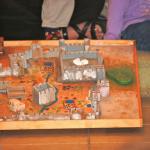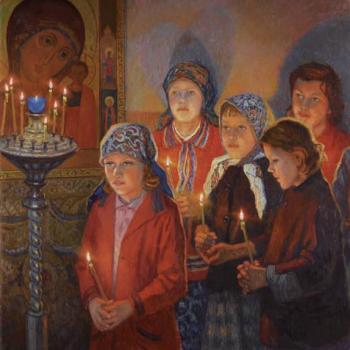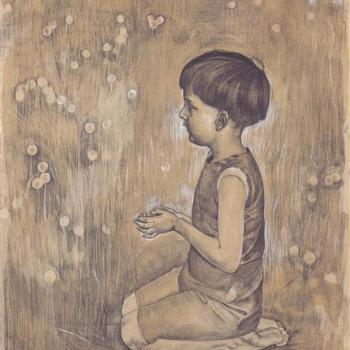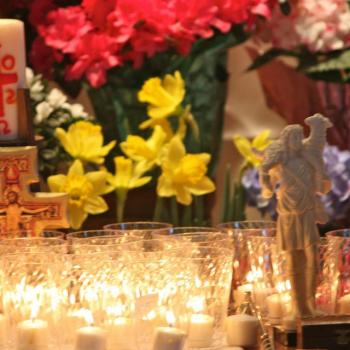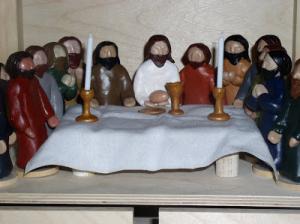
Since 1997, I have belonged to five parishes, but no matter where I am during the Triduum, each year* I have offered a series of three catechetical lessons, open to any children and their parents. In almost every case, these parishes have welcomed these presentations into the church proper (one year we had to retire to the church basement), and I have done them for the children at the foot of the altar. The first presentation is called “The Cenacle/Celebration of the Last Supper.” To introduce this scripture, I begin by discussing the meaning of the Passover: an annual meal and great prayer that the Jews observe to celebrate that God sent Moses to free them from slavery. We dwell together on the amazing fact that the Passover Jesus celebrated at his Last Supper was the same one that had been celebrated for thousands of years, except that this time Jesus spoke some new words, great and loving and precious words that had never been said during a Passover before. Then I use the model, pictured above, and read from the Gospel (from the “real” Bible) account of the Last Supper. First the figures of St. Peter and St. John are sent to the city to prepare the room, then Jesus and the Twelve file into the model cenacle. The scripture ends with Jesus and the apostles singing a hymn and then going off to the Mount of Olives. The table, with its plate of bread and its cup and unlit candles are left alone in the room. We sing a hymn ourselves. Then I ask the children if they know what happened to Jesus as he was praying on the Mount of Olives that night. Once we establish that Jesus was arrested and died on the cross, I place a small standing crucifix on the little table. “But what happened on the third day?” All the children are bursting to share the news: “He rose from the dead!” So then I light the candles. The model cenacle now looks like this:
Then I ask the children, “What were those new, surprising, and loving words that Jesus said during the Last Supper that had never been said before at a Passover celebration?” The children, even the three year-olds, are so eager to tell me: “This is my body, take and eat…This is my blood…drink it in memory of me.” We revel in the moment and then I ask them, “Where do we hear these same words today? Who says them?” Someone knows: it is the priest. I ask, “But whose words are they?” They all seem to understand that these words don’t really belong to the priest, that he is repeating the words of Jesus. “He promised that he would always be with us, and he is! Jesus is with us still!” We sing some more, and then I invite the children to say something to Jesus for this amazing gift of himself that he gives to us. “Thank you;” “I love you;” “Thank you for feeding the sheep” (from a child who is familiar with St. John’s parable of the good shepherd); “I want to be worthy of this;” “You’re the greatest!”
When this presentation is over, we spread a large white sheet on the ground, I place a plate with a matzoh cracker on it and a chalice filled with grape juice on the sheet, and we each choose an apostle to be at the Last Supper. Each year I use a different method for deciding who will get to be Jesus (youngest child there, oldest child there, guessing numbers, etc.). After I begin reading the Gospel again, it is that child’s job to repeat the words of Jesus after I read them and to break the matzoh into enough pieces that everyone can have one. We pass the plate and the cup (with a napkin to wipe the lip). We sing another hymn when it is time for Jesus and his followers to go to the Mount of Olives. Then we remember his death and Resurrection again (placing a large standing crucifix on our “table” and two full-sized candles and lighting them). We recall again the new, loving words Jesus spoke that night and try to imagine what it was like to be there, hearing them for the first time. We sing and pray some more, and then we all process to the church vestibule for more matzoh and grape juice until everyone’s had their fill and is ready to go home.
From Catechesis of the Good Shepherd presentations developed by Sofia Cavalletti and her collaborators in her catechetical center in Rome.
- There have been years when I have been unable to offer these lessons.


